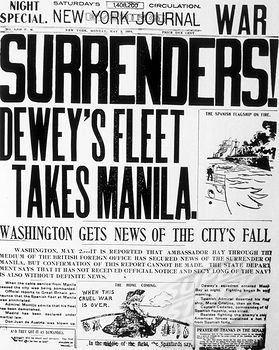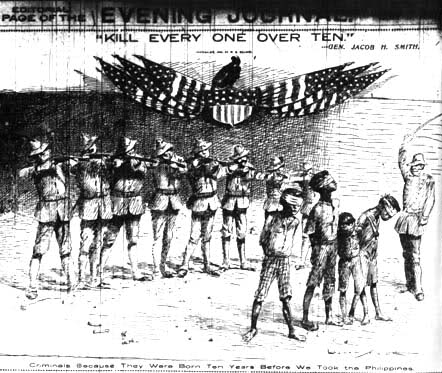The Dewey Monument Project
1 Mar 2012
The video projection/dance performance will take place in San Francisco's Union Square on Memorial Day Weekend 2012.
In collaboration with Filipino/African American choreographer and artistic director of the Push Dance Company, Raissa Simpson, a rarely seen dance work, Bitter Melon, and a movement-based video projection utilizing two oversized 3D projectors will take place on the evenings of Friday May 25th, Saturday May 26th, Sunday May 27th and Monday May 28th, 2012 in Union Square, San Francisco. This year marks the 112th anniversary of the Filipino-American war.A History of Wars
The Spanish American War of 1898 and the Philippine War that succeeded it were milestones in America's expansionist role in the world.
For the United States the story began in Cuba. In Cuba and the Philippines, independence movements were fighting against Spanish colonialism in the 1890s. After the unexplained explosion of the battleship U.S.S. Maine in Havana Harbor in 1898, there was enthusiastic support for a U.S. war with Spain. The U.S. Army fought side by side with Cuban Revolutionaries to free Cuba. The Asiatic Squadron under Commodore Dewey destroyed the Spanish Pacific Squadron in Manilla Bay just before the U.S. Army landed in Cuba. When President McKinley bought the Philippines from Spain in 1899, Filipinos kept on fighting for their independence, now it was against the United States.
Mayor James Phelan, Democratic Mayor of San Francisco from 1897 to 1902 invited renowned architect, Daniel Burnham, to design a grand but ultimately unrealized plan for San Francisco's monuments. Burnham was on his way through San Francisco to carry out U.S. Government projects in the Philippines, when the request was made.
During McKinley's term from 1897 to 1901 he led the war against Spain in 1898, the Philippine War in 1899 and the annexation of Hawaii, acquisition of Guam, Samoa and the Philippines. In 1904, McKinley was assassinated.
Just before the end of his term in 1901, McKinley broke ground for the Imperial Victory Column in San Francisco's Union Square to celebrate the U.S victory over the Spanish. President Roosevelt dedicated the monument on May 14th 1903 and delivered a speech on the importance of the modern navy. Roosevelt would continue to assert America's military power in the Philippines and on the world stage.

It was in this context, within a spirit of expansionism and militarism which has continued throughout much of the 20th century, that the Dewey Monument was born. The monument commemorates the destruction of the Spanish Fleet in Manila Bay in 1898 and legitimizes the memory of this victory. It is, in fact, crowned with a victory statue of the Greek Goddess Victoria of Germania and stands on a base inscribed with five text panels praising the military win.
Today, multiple chain stores such as Macy's, Tiffany's, Neiman Marcus, Saks, as well as high-end hotels such as the St. Francis surround the square. Every day thousands of tourists frequent the area perhaps unaware that the monument represents a great naval victory and a colonial expansion that opened doors for the many multinational corporations represented in businesses in Union Square to globalize overseas and dominate in domestic markets. The green patch around the monument, and the streets bordering Union Square are, however, also a frequent site of demonstrations, most recently, in solidarity with the worldwide "Occupy Wall Street Movement" which started in September 2011 as a protest against financial control of education, populations, and urban space by banks and corporations. The Occupy Wall Street movement was, in turn, inspired by unrest and popular uprisings in Egypt and Tunisia.
The Wall Street demonstrations took place in Liberty Square, NYC, which, like Union Square, is another central, symbolic site of American democracy - a "town green" or "commons."
For nearly 110 years the Dewey monument has stood celebrating colonial expansion and the subsequent war. It has stood as a silent witness to immeasurable tragedies in those wars, at the same time overlooking a place of counter-resistance and protest. What does the monument remember? What would happen if the monument had the chance to speak about the horrors to which it has been eye witness? What would be its testimony? In this art project, planned for Memorial Day Weekend 2012, projected light will burn into the "consciousness" of the column's concrete, an indelible "after image" that will not fade with daylight.
How might these consumers become activated by the story of monument? What might they do, say, and how will they act in response to the projection?

The Memorial Day Performance and Column Projection
The monument will come to life as an urban witness bearing both visual and audio testimony as evidence of its meaning in relation to U.S. militarism and global expansionism. First the monument will "talk" about its beginnings, then about its own implications today.
Figures will animate on the monument column, actualizing the story of the American war with Spain. The victory statuette will come to life on the column itself as performers dressed in period attire dissolve into the architecture. Monument and performers will become one as the Push Dance troupe collaborates to explore the obligatory parallels of cultural histories and tragedies of African Americans and the native people of the Philippines in the context of war. By examining the deficiency of the humanitarian aid in response to flood disaster and with a particular emphasis on water torture, a method used where the tortured was forced to drink large quantities of water in a short period, and which dates back to the 15th century, yet was first used to reference activities during the Spanish American War in 1898, utilized by American soldiers, the dance company will link African American and Filipino American histories to water, a source of natural disaster, of suffering and of rebirth.
How are we to excavate this history within the monument? How may we reveal the story of this monument?
The Dewey Monument was specifically designed to perpetuate a myth of military superiority for generations. This story has become deeply embedded within the fabric of our architecture, society and collective consciousness.
How can the monument counter this? What audio visual tactics can be employed to bring the stories of the monument to life?This artists' project is a collaboration between Ben Wood and the Push Dance company. For more information:
Links
Push Dance CompanyBen Wood -Large Scale Projection - New Media
Images courtesy of BayanUSA and Superstock.com.
Filipino-American war history